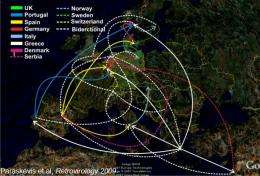HIV's march around Europe mapped

Those travelling abroad should take seriously advice to pack their condoms and keep their needles to themselves: research published today in the open access journal Retrovirology shows that tourists, travellers and migrants from Greece, Portugal, Serbia and Spain actively export HIV-1 subtype B to other European nations.
An international team of scientists used samples from 17 European countries to construct a viral phylogeography - a geographic pattern of genetic information taken from viruses at a number of locations that can be used to track how and when it spread (this technique has recently been applied to the bird flu virus H5N1.) HIV-1 subtype B is the most prevalent form of the HIV virus circulating in Europe today.
The results showed that for three countries (Austria, Poland and Luxembourg) no significant exporting migration was observed. Whereas Greece, Portugal, Serbia and Spain were a source of subtype B to other countries. Notably, the virus spread widely from Greece and Spain to seven and five target countries respectively. Other countries had narrower targets, with Italy exporting HIV to Austria, and Portugal passing the virus primarily to Luxembourg (some 13% of Luxembourg's population is Portuguese). Other nations such as Austria, Belgium, Denmark, Germany and Luxembourg showed only limited export of HIV-1 subtype B, while for Italy, Israel, Norway, the Netherlands, Sweden, Switzerland and the UK the authors inferred significant bidirectional migration. For Poland no significant migration was found.
According to the first author, Dimitrios Paraskevis, 'Popular tourist destinations like Greece, Portugal and Spain probably spread HIV with tourists infected during their holidays. To a large extent HIV spread within Poland is due to injecting drug users, who make up around half of the HIV-infected population. Viruses move around with travellers - thus health programmes within countries should not only target the national populations, prevention efforts must also be aimed at migrants, travellers and tourists - who are both major sources and targets of HIV.'
More information: Tracing the HIV-1 subtype B mobility in Europe: a phylogeographic approach, Retrovirology (in press), www.retrovirology.com/
Source: BioMed Central (news : web)















